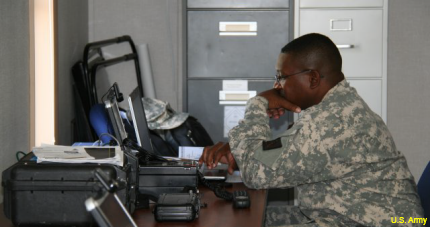Chem-bio-nuke teams test briefcase communications system
The portable GRRIP lets response teams set up quickly and send back data and imagery from potential disaster sites.

Lt. Col. Dirk Barber trains on a GRRIP in preparation for NIE 16.1.
Soldiers who respond to disaster sites posing potential chemical, biological or nuclear threats will soon test a briefcase-sized communications system that will let them securely send forensic data and check in with subject matter experts.
Response teams from the Army's 20th Chemical, Biological, Radiological, Nuclear, and Explosives (CBRNE) Command trained on the system last month at the Edgewood area of Aberdeen Proving Ground, Md., and will test it in realistic scenarios during the Network Integration Evaluation 16.1 exercises set for October at Fort Bliss, Texas.
The communications system is the Global Rapid Response Information Package, known as GRRIP, which provides an IP connection via the Defense Department’s classified and unclassified networks for voice, data and video without the need for local communications infrastructure.
GRRIP “provides early entry reach-back from an event site anywhere in the world," Lt. Col. Dirk Barber, task force chief of CBRNE’s Nuclear Disablement Team 3, said in a release. "It enables us to move forward more quickly and confirm the severity of a target faster than in the past, possibly preventing the enemy from using capability against us."
The Army has used GRRIP during the drawdown in Afghanistan to fill communication gaps as infrastructure was taken down and shipped back home. The kit, which can be set up in less than five minutes and configured for the classified SIPRNet, the non-classified NIPRNet or the CX – Korea network, supplies a secure IP connection to the military’s CX-I network. In talking about its use in Afghanistan last year, Army officials said that disaster response would be another likely use for GRRIP.
At NIE, teams will test reset GRRIPs and a larger device, the SIPR/NIPR Access Point (SNAP) satellite terminal, in an effort to determine the requirements for communicating from the site of a chemical, biological, radiological, nuclear or explosives event, the Army said.
The system will allow response teams to set up quickly and send back data and imagery—such as nuclear spectra data or images of a chemical site—to outside experts, whether in defense or civilian agencies, for advice on how to proceed.
"With GRRIP we can paint a picture of the battleground, a common operating picture for the commanders, so they can make informed decisions as to what needs to be done for those particular threats," Barber said. "Do we need to place the site on security; do we need to bring in more Soldiers; do we need to abandon it; is it going to pose a threat to those individuals that are there?"
Eventually, the Army plans to move on from GRRIPs and SNAPs to new light and heavy solutions being developed under it Transportable Tactical Command Communications (T2C2) program.
NIEs are large-scale exercises during which the Army spends a couple weeks testing various aspects of its battlefield network. The service has held them twice a year since 2011, although starting in 2017, it will hold just one NIE a year, replacing the second NIE with the Army Warfighting Assessment, which will incorporate the other military services and multinational forces.